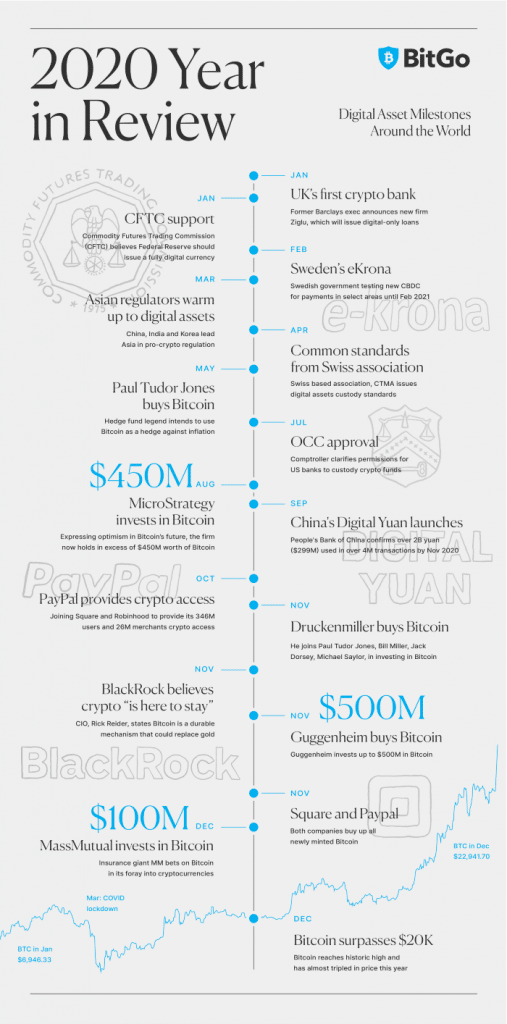It’s been a year of unprecedented socio-economic and cultural change that has redefined every aspect of our lives. The crypto-asset industry has been no exception. As we finally close the book on 2020 and open the door to an uncertain 2021, let’s take a look back at the year that was.
Here follows the biggest regulatory moves of the year as well as an overview of the progress Sygna Bridge made in 2020.
Traditional finance and crypto finally converge
The year 2020 was a watershed year in every aspect for crypto mainstream adoption (and regulation).
The first first 9 months delivered a surge in the popularity of decentralized finance (DeFi) and peer-to-peer transfers that brought their own regulatory challenges, while the 2nd half brought accelerated mainstream adoption and insatiable demand from financial institutions such as MassMart, MicroStrategy, Grayscale and PayPal, propelling Bitcoin’s price to new heights.

However, the final quarter of 2020 saw discouraging regulatory intervention against BitMEX and Ripple, as well as a slew of regulatory proposals in the U.S. that did nothing to dampen market sentiments.
The latest wave of price action to record highs is driven by a seemingly insatiable institutional demand for Bitcoin, after a decade of regulatory uncertainty came to an end.
The FATF Travel Rule
The Financial Action Task Force (FATF) followed up on its 2019 adoption of Recommendation 16’s new “Travel Rule” guidance with its first 12-month review in June 2020. The follow-up review assessed the regulatory progress made by member nations and the private sector, specifically Virtual Asset Service Providers (VASPs) and technical solution providers (TSPs) such as Sygna Bridge.
The FATF recognized industry progress and announced a second Travel Rule review in June 2021 to meet enhanced Travel Rule implementation.
In the face of growing support for new fields like DeFi, peer-to-peer transfers, stablecoins and CBDCs, the FATF has acknowledged the need to monitor and identify emerging risks. This will be something to look out for in its second review come June 2021.
Global Regulatory Roundup
Asia continues to lead the way in crypto adoption
In 2020, Asia continued to lead cryptocurrency adoption and effective regulation. Jurisdictions such as Singapore, South Korea, Japan and Hong Kong have recognized the advantage of being a first-mover in crypto regulations, and clearly taken the Travel Rule and other FATF guidance into consideration when developing frameworks for regulation.
Singapore garnered industry praise with its regulatory developments in the crypto asset space, exceeding even FATF Travel Rule requirements with the Payment Services Act (PSA) enacted this year.
The U.S. is still playing cat-and-mouse with crypto companies
In North America, U.S. regulators, led by outgoing appointees of the Trump administration, made several strong plays, both good and bad for the crypto industry. In July 2020, the U.S. federal banking regulator Office of the Comptroller (OCC) clarified that banks could indeed offer custodial services to crypto investors.
Not all news after that was positive:
- October: FinCEN proposed that the Bank Secrecy Act (BSA) data-collection requirement threshold for MSBs be lowered from $3,000 to $250 for funds transfers
- December: FinCEN proposed that MSBs like crypto exchanges must collect KYC data on transactions with “unhosted” AKA private wallets. The industry is given 15 days to respond
- December: Democrat congress members put forward the Stable Act to hold stablecoin issuers to the same standards as banks (December) and also vouch to roll back the OCC’s crypto reforms
- October/December: The CFTC and SEC respectively charged BitMEX and Ripple with violating U.S. financial laws
With the Biden administration not commiting to a firm stance on the crypto industry yet, there is warranted uncertainty as to which direction the new U.S. government will take on crypto regulations.
Europe goes long on digital finance
Across the pond, the European Commission followed up the January promulgation deadline of its 5th Anti-Money Laundering Directive (AMLD5) by proposing a comprehensive Digital Finance Strategy framework, which covers cryptocurrency regulation in its Markets in Crypto Assets (MiCA) proposal and is expected to only come into effect in 2024. Unresolved issues such as data privacy and the drawn-out Brexit agreement further complicate the European landscape.
Africa and Latin America test the waters
Africa and Latin America present some of the most compelling use cases for cryptocurrencies, yet still suffer slow regulatory reforms as governments adopt a “wait and see” approach, perhaps waiting to see what Asia, Europe and the U.S. do first given the larger volumes from those regions. South Africa continues to be an outlier, following their 2019 efforts with new draft recommendations that crypto assets be treated as a financial product.
Private sector interoperability
Crypto’s private sector rallied collaboratively to build new solutions meeting FATF guidance. The Joint Working Group (JWG), created by the Chamber of Digital Commerce, Global Digital Finance and the International Digital Asset Exchange Association, unveiled the first unified messaging standard for information sharing with its InterVASP Messaging Standard (IVMS101) in May 2020, which was subsequently integrated and is being utilized by Sygna Bridge.
This interoperability across solutions is considered essential for VASPs, who will potentially engage with different solutions, and has been prioritized by the FATF in its 12-Month Review. It will likely continue to foster closer industry cooperation until the FATF’s next review in mid-2021.
CoolBitX and Sygna Bridge: 2020 Highlights
Series B funding
As the world adjusted to the “new normal” in early 2020, CoolBitX announced the conclusion of a successful Series B funding round of $16.75 million in investment from SBI Holdings and others.
CoolBitX continued to focus its attention on perfecting Sygna Bridge as the first-to-market Travel Rule solution and building out strategic partnerships within the industry while engaging regulators and regional industry bodies globally, with an emphasis on Japan, Hong Kong, Korea and Singapore. CoolBitX participated in several key virtual industry events such as Consensus:Distributed and V20.
Production test
In early 2020, Sygna Bridge conducted a successful Big 4-audited production test between three leading exchanges: SBI VC (Japan), BitoPro (Taiwan), and BitSonic (Korea).
Elliptic partnership
In July Sygna Bridge and Elliptic joined forces in July to offer VASPs access to both Travel Rule compliance and blockchain analytics services. The companies conducted a series of Travel Rule compliance seminars, with a specific focus on Singapore regulation that was supported by its leading blockchain association ACCESS Singapore. The partnership continues to evolve and should see even further convergence in 2021.
Sygna Bridge 2.0 and IVMS101 integration
Following the release of IVMS101, CoolBitX rolled out Sygna Bridge 2.0 in Q3 2020, establishing it as one of the first technical solutions to adopt the nascent messaging standard.
Interoperability PoC with CipherTrace
Sygna Bridge built on this momentum with a proof-of-concept transfer between it and CipherTrace’s TRISA in September.
ACCESS report and Top 50 award
CoolBitX received further industry validation in Q3 2020 when ACCESS Singapore released a favorable independent assessment on Sygna Bridge and the company was recognized by CB Insights as one of its Top 50 Blockchain companies.
Sygna Alliance reaches 25 members
These landmark achievements and office expansion to Japan and Korea has seen the Sygna Alliance membership grow to 25, with partnering VASPs now located across Asia, Europe, North America, Africa and Australia.
Regulations: What to Expect in 2021
While COVID-19 is expected to continue adversely affecting every economy on earth, a few things are certain. There is no reset button on plans to regulate the crypto industry. And no company is too big or small to ignore.
Recommendation 16 is the first of several other pieces of guidance we can expect from FATF. It may be reasonable to expect something on P2P guidance from FATF in 2021 given the FinCEN attempt, which will build upon R.16.
VASPs will also likely have to contend with increasing global regulations that demand more of them in terms of information-sharing, AML compliance and interoperability, which will force them to build out their AML strategies in anticipation of more regulatory scrutiny and greater competition to come.
Stringent regulations will continue to create trial-by-fire challenges for VASPs and put ill-prepared ones to the sword as bigger institutions enter the industry and market forces become stronger. From the momentum created in 2020, it is foreseeable that the convergence of traditional finance and the crypto industry through tighter regulation will continue unabated.


